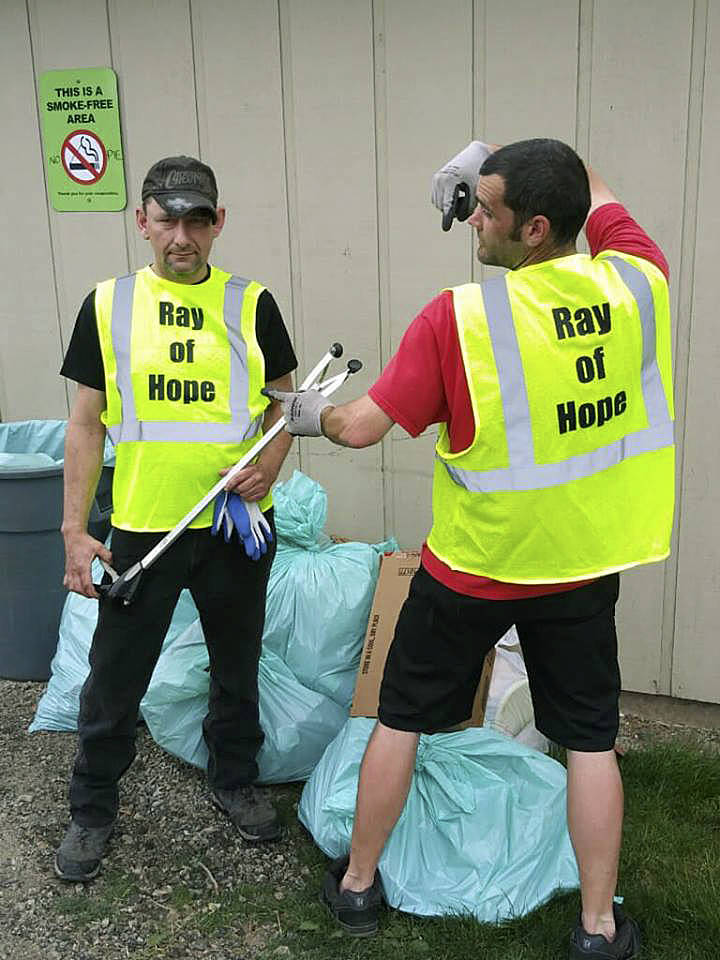Perhaps you spotted them recently – a group of homeless folks in neon-colored vests with the name of the “Ray of Hope” day shelter on the front and back, volunteering to clean up Brannan Park ahead of a community picnic.
Or maybe you saw them when they were out and about cleaning up the banks of the Green River, or tidying up the Valley Cities campus, or sprucing up the shelter itself.
If so, what you observed was an early but hopeful step toward realization of one of the 46 recommendations of the Mayor’s Task Force on Homelessness in April 2016: to create a program that hires the homeless daily to help clean the community.
“We’re exploring that opportunity as something that we could take on possibly as a city,” Dana Hinman, administrative director for the City of Auburn, told a recent study session of the City Council, where she brought city leaders up to speed on progress made. “We can tell you that is essentially going on at the Ray of Hope Shelter. (Auburn Food Bank Director) Debbie Christian has them out there working, and she loves to post it on Facebook.”
“I’m excited about the prospect of it,” Christian said. “We are currently using our residents in sort of this pay-back fashion. I’ve told them all that it’s a low barrier to come in, but it’s a high barrier to be able to use the facility and stay. And by high barrier, the expectation is your behavior will fit, and you give back the same way I’m giving to you. We’re giving you something, and we need a give-and-take here. If you can’t do much but clean the spot on the table where you are sitting and eating today, that’s all I care about. Do something, something that is out of your daily routine.”
In the “accomplished column” Hinman tallied a task force recommendation that Auburn Police have information to distribute to the homeless about services, shelters and referrals.
“Our patrol officers all carry information as a resource, so that people can move into better situations than they are found in,” Hinman said. “Kudos to our police officers, and how they are offered the latitude to have it not always be something that ends up in an arrest.”
A recommendation to expand emergency shelter options to youth under 18 years of age saw progress in 2017 when King County offered Nexus – formerly Auburn Youth Resources – close to $500,000 to reopen a 12-bed facility for youngsters.
Another recommendation now “in progress” was to increase the supply of low-barrier shelter beds, that is, beds without a worrisome number of conditions homeless people must satisfy before they are admitted to shelters.
“The overnight shelter at Valley Cities is averaging about 40 a night. That is a low-barrier shelter again staffed by the philosophy of Debbie Christian,” Hinman said.
Given concerns about the growing homeless population in Auburn, Mayor Nancy Backus created the task force to combat homelessness in November 2015.
Composed of residents, businesses, service providers, churches and community stakeholders, the task force met with city and regional government representatives, regional homelessness response coalition staff and service providers who work in Auburn seven times between November 2015 and April 2016. They visited agencies in Auburn and within the South King County region that serve homeless people and recorded interviews with some of Auburn’s homeless population.
Despite such hopeful progress, Hinman noted, more work remains to be done.
Consider the following facts about poverty in Auburn and in South King County:
• More than 10 percent of Auburn families fell below the federal poverty line in the 2010 U.S. Census;
• According to the most recent U.S. Census data, 17 percent of Auburn’s population lives below the poverty line, and according to the Auburn School District, slightly more than 50 percent of students enrolled in Auburn’s schools today qualify for free-and-reduced lunches;
• Rental costs in South King County have increased 27 percent since 2010. A person earning minimum wage, or on welfare or receiving Social Security disability income cannot afford an average one-bedroom apartment in South King County;
• In South King County, 100,800 households, 38 percent, pay more than 30 percent of their income on housing. That percentage is significantly higher if one looks only at renters or at people living on low incomes. According to American Community Survey 2016 data, of Auburn households, 35.9 percent is paying more than 30 percent of its income on housing. When you look only at renter households, that percentage is 48.9 percent.
• Rental costs have increased 34.4 percent since January 2012, according to Zillow Rent Index data.
In 2015, 871 Auburn families applied for public housing assistance – seeking to get on the King County Housing Authority Section 8 Voucher waiting list. Only 98 of those applicants were fortunate enough to get a slot on the waiting list – and they can expect to wait as long as five years for space in public housing to open up.


